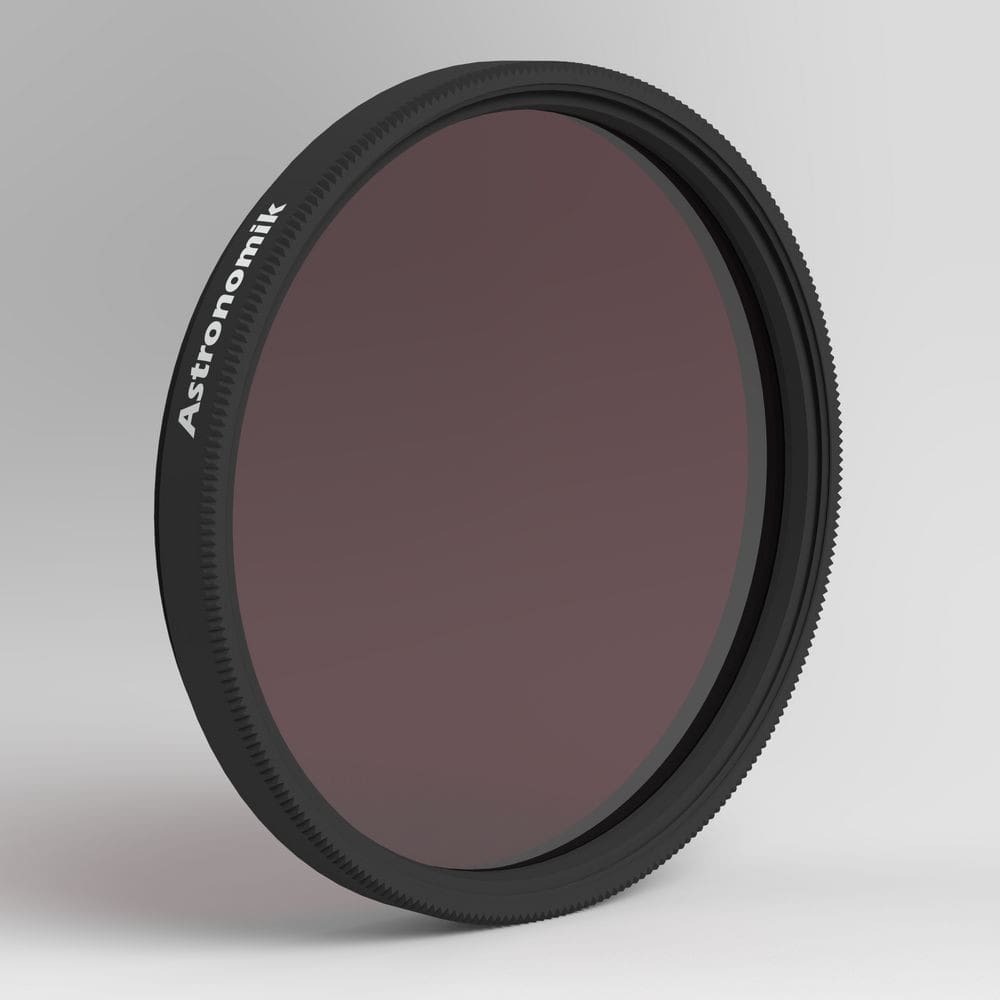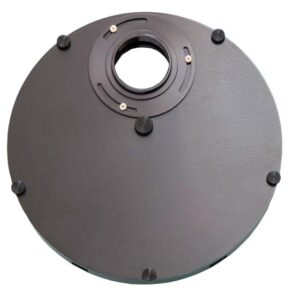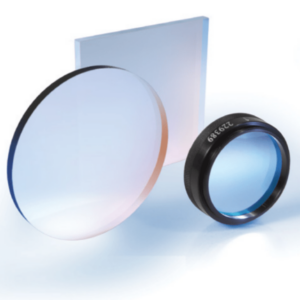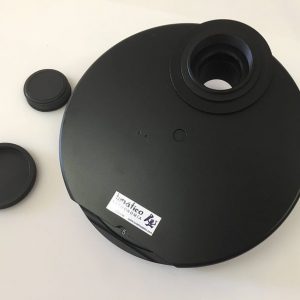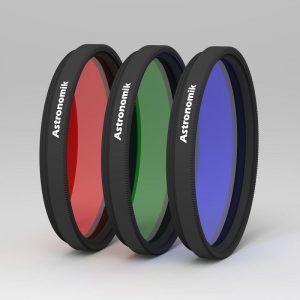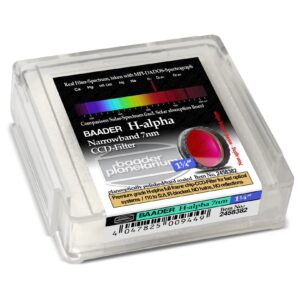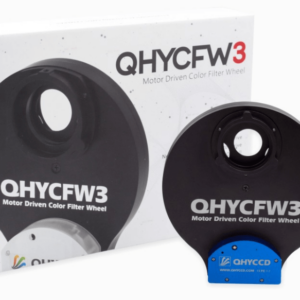Astronomik H-alpha Narrowband Filter
136,50€ – 485,50€
Astronomik CCD H-Alpha filter – Narrowband
Available in 12nm and 6nm.
-
- 12 nm for all DSLRs and dark-current limited cameras.
- 6 nm for observing sites with extreme strong light pollution, cameras with low dark-current, and when weak objects require the maximum contrast and star-reduction possible!
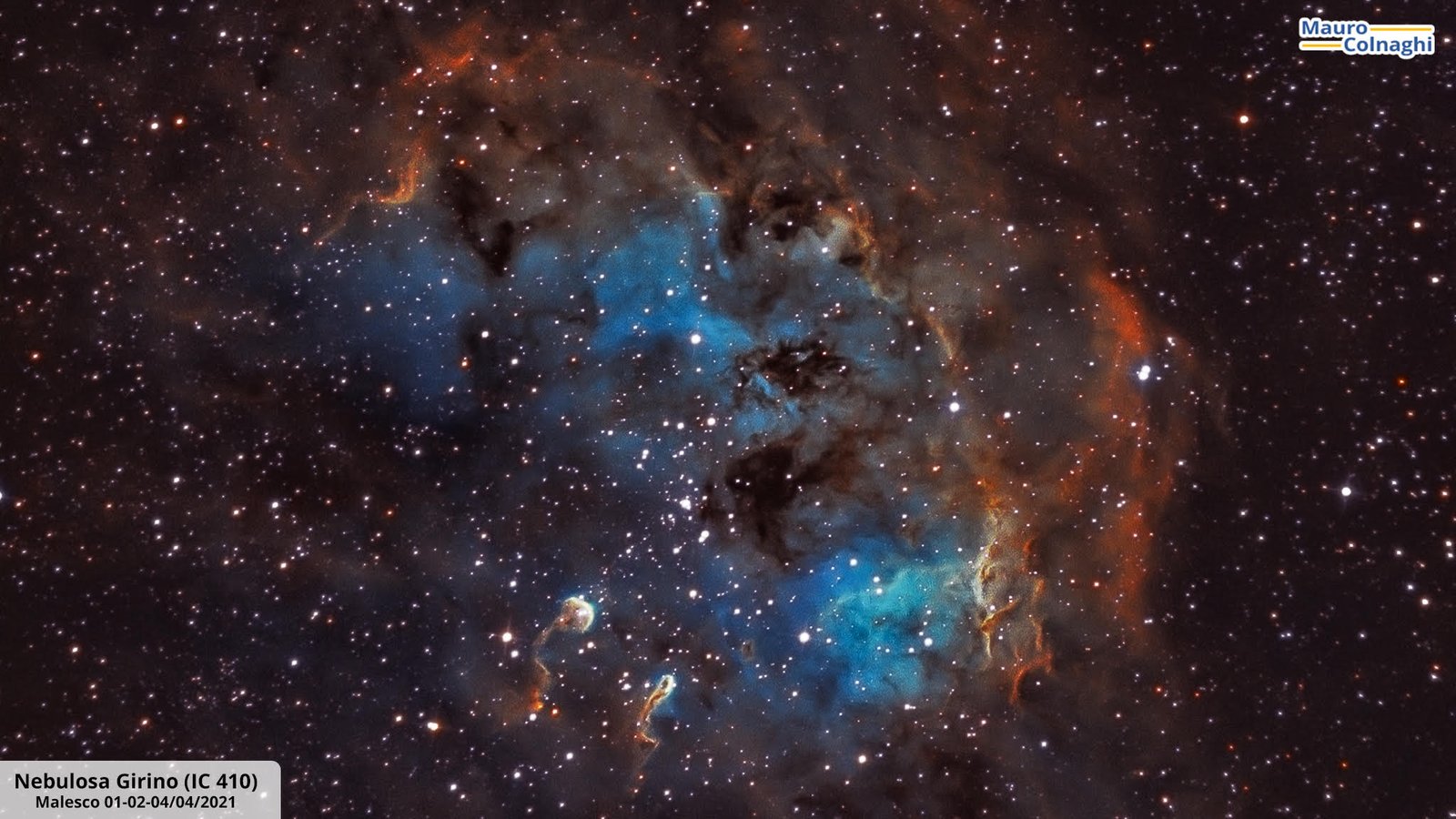
The new series of Astronomik MFR Narrowband-Emissionline Filters is perfect matched to the requirements of astronomical Deep-Sky imaging. For the three most important emission lines of Oxygen (OIII), Hydrogen (H-alpha), and Sulfur (SII) you may select your filters either with 12nm or 6nm Bandwidth (FWHM).
Our new filters are made in completely new construction, which makes the best Out-of-Band blocking possible across the whole range of wavelengths from the UV up to IR! Your advantage of our new design is an extremely high contrast, minimized stray light, no halos, and needle-sharp stars. With the new Astronomik MFR Narrowband-Emissionline filters, you get data with the best quality possible: The best starting material to be processed to an awesome final image!
To get the maximum from the valuable observation time you need filters with the highest transmission possible. We do guarantee transmission of 90%, but typically the transmission is as high as 96%. These values are valid for the 12nm and the 6nm filters as well!
For maximum contrast, the SII filter is carefully designed to block all light coming from H-alpha and NII (nitrogen).
Due to the new MFR coating, the new Astronomik Narrowband filters can be used on nearly all instruments and save you money.
Contrary to filters from other manufacturers the transmission curve of the new Astronomik Narrowband-Emissionline filters is nearly not shifted when used with fast optical systems! While other manufacturers sell special “High Speed” filters or you even have to buy a new filter for each scope, this is not the case with the new Astronomik Narrowband-Emissionline filters with MFR coating. Save lots of money as you may use all filters with 12nm Bandwith (FWHM) with any instrument up to f/3 and all 6nm filters up to f/4!
Imaging with Narrowband-Emissionline Filters
If you have to observe from light polluted sites (like most of us…), imaging with Narrowband-Emissionline filters is the best way to take great images, as all kinds of light pollution can be blocked very effectively! Normally an H-alpha filter should be your first step into this amazing field of astrophotography!
- With a Narrowband H-alpha filter, you will be able to take deep and contrast images even with very heavy light pollution or with the full moon high up in the sky! If you look at other astrophotos, an H-alpha is the best choice for all nebulas glowing red!
- An OIII filter expands your imaging possibilities, as you are able to image all greenish/blueish structures. Planetary nebulas and star-forming regions are great targets!
- The SII filters complete your HSO-set of filters.
With these three filters, you are able to process your images like the ones from the Hubble space telescope!
Note: The h-beta filter is not available in a 6nm version, as this filter has nearly no meaningful application.
Quality aspects of the new Astronomik MFR Narrowband-Emissionline Filters:
- MFR Coating: The 12nm Filters can be used on all instruments up to f/3, the 6nm filters up to f/4. (Filters for faster optics are available upon request, contact us at info@lunatico.es).
- High-Quality substrate: Astronomik filters are made with stress- and striae free, optically polished glass. The filter itself is made of ultra-thin layers on this substrate!
- Parfocal filters: All Astronomik Filters are parfocal! Due to the very small thickness-tolerance, the focal plane is not shifted when changing filters! We have supplied parfocal filters for optical systems as fast as f/1!
- Coating: Astronomik filters are made of up to 130 layers that are coated on both sides of the substrate. These layers form the filter itself and act as an Anti-Reflection Coating.
- Durability: Due to our coating technique all Astronomik filters are highly scratch-resistant, not sensitive to moisture, and do not degrade when getting older. -Every Astronomik filter will deliver its full performance and meet the specs at the point of shipping even after lots of years.
- Integrated Blocking: All unwanted light is blocked in the whole spectral range from UV up to the IR! (You will not need an additional UV & IR-Blocker when imaging with the new Narrowband-Emissionline Filters with MFR coating!)
- Wide range of available sizes from 1,25″ up to square 50mm x 50mm filters, contact us at info@lunatico.es if you don’t find your filter in the drop-down.
- Delivered in a high-quality Protection & storage box.
- Due to our outstanding Coating technique, Astronomik does offer a 10-year guarantee on all of our filters.
You get the highest quality possible with every single Astronomik filter to be able to take perfect images with your instruments! Especially the filters against Lighpollution and the Narrowband-Emissionline filters will expand your imaging possibilities enormously! You are investing your money for an accessory that will work in lots of years in the same ways it did when it was brand new. Due to our special coating technique, the filters do not degrade when getting older, and due to the new MFR coating you will be able to use the filter on nearly all instruments!
Transmission curves:
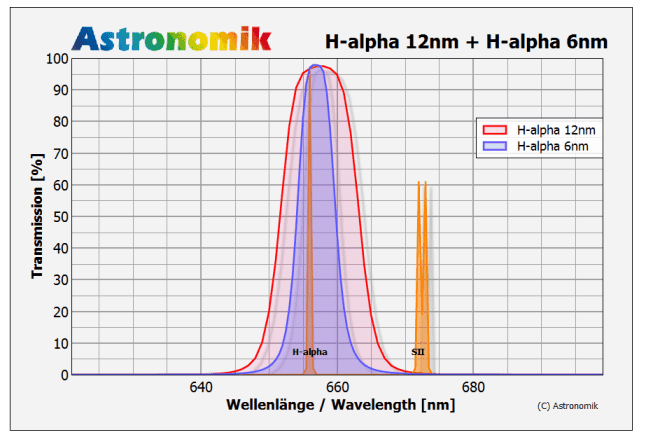
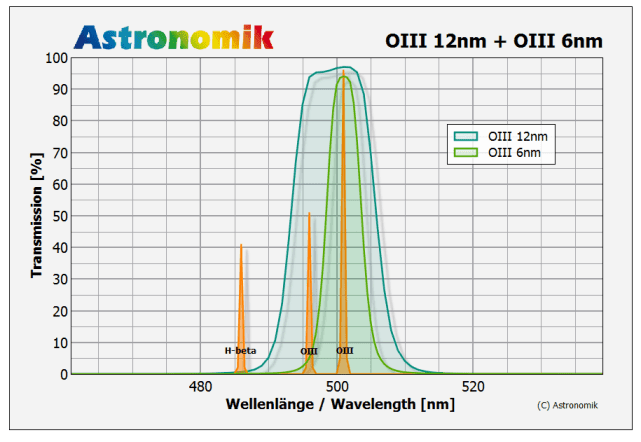
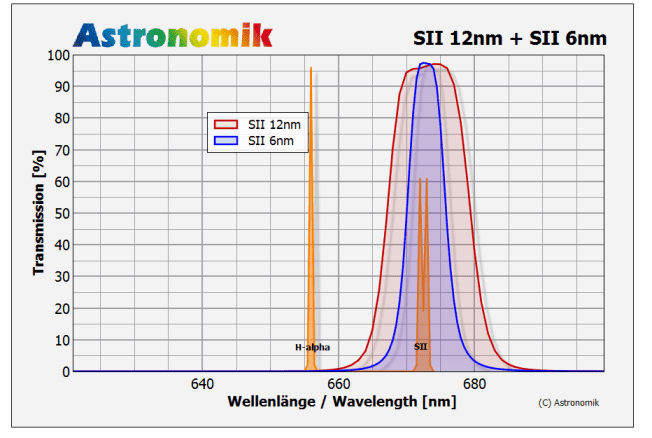
| (*) Image details: 39 x 240 sec Ha Astronomik CCD 12nm 36mm 39 x 240 sec OIII Astronomik CCD 12nm 36mm 39 x 240 sec SII Astronomik CCD 12nm 36mm Newton D: 305mm F: 1200mm F/4 – QHY 163m camera – iOptron CEM70 |
FAQ around Narrowband-Emissionline Filters:
- Which Full-Width-Half-Maximum is the best one for me? 12nm or 6nm?The question which Full-Width-Half-Maximum (FWHM) is the “best”, shows up in eMails on our monitor or when talking to customers at fairs very often. A general “right” or “wrong” or “best” does not make any sense. -We would not offer both series if they were not needed.
When imaging from the city/suburb the images taken with DSLRs and most CCD cameras are limited by the dark current of the sensor and not by the brightness of the sky background. In this case, you will not see fainter structures when using a 6nm filter instead of the 12nm version. Additionally to those cameras with an integrated guiding sensor will get more stars for guiding with the 12nm filters!
If you have a camera with an extremely low dark current and effective cooling, the 6nm filters will give you major advantages: Due to the stronger blocking of the background, you will be able to expose longer and get deeper images! All stars are very tiny points, most faint stars do not show up anymore! -This is a major advantage even for normal cameras, as you can take images of faint structures even in star-crowded regions of the Milkyway!
To put it short: 12nm Filters are the right choice for all DSLRs and dark-current limited cameras.
6nm filters are the best choice for observing sites with extreme strong light pollution, cameras with low dark-current, and when weak objects require the maximum contrast and star-reduction possible!- How much is exposure time increased?
This question is asked quite often, and the answer is very easy: You don have to expose longer, but you MAY expose longer!
Due to the high transmission of approximately 100% at the center wavelength nearly all these photons reach the sensor. So the number of fr example “H-alpha-photons” does not change significantly whether an H-alpha filter is installed or not. But looking at the photons of another wavelength, which we do NOT want to record makes the effect of the filter clear: The combination of a very good blocking of all unwanted light from UV up to the IR and the narrow bandwidth of the filters reduces all unwanted signal on the sensor! If you do an exposure of 30sec without any filters from a light-polluted urban observing site, your sky-background might be already very, very bright, or even saturated. The same image taken with a Narrowband-Emissionline filter will give you a perfect black background without any signal and the signal from the object will be about the same. With this black background you have the possibility to expose longer -probably 30min instead- to record fainter structures! So it, not a “must”, it´s a “may“.
Available in other sizes and formats. If you do not find the size you want, contact us at info@lunatico.es.
| Filter thread | 1,25", 2", Ø 36 |
|---|---|
| Nm (FWHM) | 12nm, 6nm |


